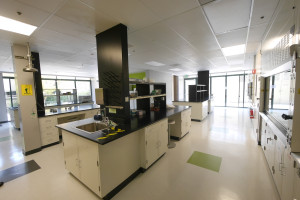StartX, the Stanford-affiliated startup incubator, announced this morning their partnership with The California Institute for Qualitative Biosciences (QB3) to open a life sciences lab customized for early stage medical and hardware device teams.

The new 2,000-square-foot lab, which will focus on developing entrepreneurs transitioning from academic to industrial research, is located close to Stanford University and Stanford Hospitals.
QB3 has launched six similar incubators near the University of California at San Francisco and the University of California at Berkeley. However, according to Andrew Lee, a current M.D./Ph.D. candidate at the Stanford School of Medicine and co-founder of the StartX Med organization within StartX, the wet lab’s proximity to Stanford University and Stanford Hospitals is one of the biggest advantages of this particular venture.
“A lot of our founders are Stanford faculty and can’t use Stanford’s own facilities [for product development at company spinouts] ,” Lee said.
Lee explained that previously, founders in need of lab space would need to commute to the San Francisco area, Sunnyvale, or as even as far as Berkeley to use lab space to conduct experiments.
“There are amazing discoveries being made at Stanford every day,” Lee continued. “The overall idea is to empower the students and faculty to transfer this technology so it doesn’t just stay in the university setting, but makes it out to help people.”
Douglas Crawford, associate director of QB3 and co-director of the StartX-QB3 labs, emphasized the benefits of supporting research with the resources that StartX would be able to provide.
“Co-locating high caliber scientific researchers within the resource-rich environment of StartX will significantly and rapidly improve the odds of success for these early stage life science companies,” Crawford said. “We are proud to support and facilitate this endeavor.”
The lab facility — built by Alexandra Real Estate, a developer that focuses on life sciences — meets stringent specifications and has an impressive equipment selection, explained Alexa Lee ’95, director of communications at StartX.
“The facility will be outfitted with essential equipment for early stage life science, chemistry and medical device startups,” she said.
The lab will have four fume hoods, a molecular biology core, a tissue culture core, an autoclave, a glasswash, workbenches and a hardware prototyping room. The hardware prototyping room has a Makerbot 3D printer, as well as a huge selection of tools and materials for rapid prototyping.
The facility also meets BSL-2 specifications, which allows researchers to use patient blood samples and specimens within the lab, said Andrew Lee, who also ensured that all personnel working within the lab must be trained in safety precautions against blood-borne contaminants and pathogens.
He also added that any untrained visitors would need a StartX staff escort in the lab, even those just walking to the hardware prototyping room.
StartX-QB3 Labs is charging a fee—starting $1,500 a month for five feet of bench space and access to the common equipment—however Andrew Lee noted that there are already companies claiming space.
“Some [companies] are taking 13 [feet], some are taking 11 [feet],” he said.
Contact Nitish Kulkarni at nitishk2 ‘at’ stanford.edu.
